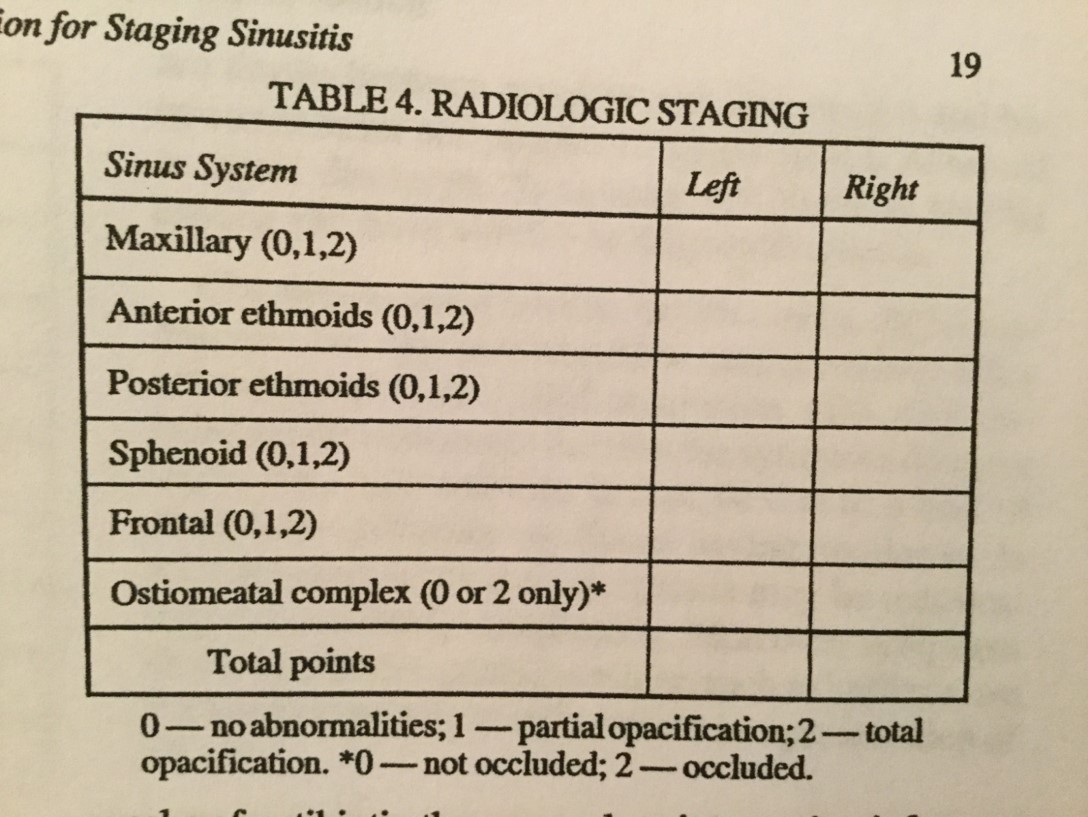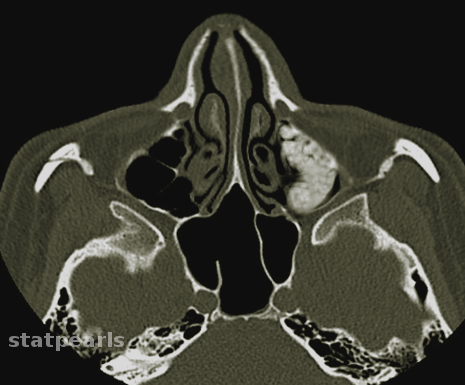[1]
Klimek L, Koennecke M, Hagemann J, Wollenberg B, Becker S. [Immunology of chronic rhinosinusitis with nasal polyps as a basis for treatment with biologicals]. HNO. 2019 Jan:67(1):15-26. doi: 10.1007/s00106-018-0557-7. Epub
[PubMed PMID: 30167718]
[2]
Pipolo C, Saibene AM, Felisati G. Prevalence of pain due to rhinosinusitis: a review. Neurological sciences : official journal of the Italian Neurological Society and of the Italian Society of Clinical Neurophysiology. 2018 Jun:39(Suppl 1):21-24. doi: 10.1007/s10072-018-3336-z. Epub
[PubMed PMID: 29904833]
[3]
Stryjewska-Makuch G, Janik MA, Lisowska G, Kolebacz B. Bacteriological analysis of isolated chronic sinusitis without polyps. Postepy dermatologii i alergologii. 2018 Aug:35(4):375-380. doi: 10.5114/ada.2018.77667. Epub 2018 Aug 21
[PubMed PMID: 30206450]
[4]
Cho HJ, Kim CH. Oxygen matters: hypoxia as a pathogenic mechanism in rhinosinusitis. BMB reports. 2018 Feb:51(2):59-64
[PubMed PMID: 29366441]
[5]
Park JJH, Seidel DU, Bachert C, Dazert S, Kostev K. Medication use in patients with chronic rhinosinusitis in Germany - a large retrospective patient-based study. Rhinology. 2019 Apr 1:57(2):94-100. doi: 10.4193/Rhin18.055. Epub
[PubMed PMID: 30076702]
Level 2 (mid-level) evidence
[6]
Philpott CM, Erskine S, Hopkins C, Kumar N, Anari S, Kara N, Sunkaraneni S, Ray J, Clark A, Wilson A, CRES group, Erskine S, Philpott C, Clark A, Hopkins C, Robertson A, Ahmed S, Kara N, Carrie S, Sunkaraneni V, Ray J, Anari S, Jervis P, Panesaar J, Farboud A, Kumar N, Cathcart R, Almeyda R, Khalil H, Prinsley P, Mansell N, Salam M, Hobson J, Woods J, Coombes E. Prevalence of asthma, aspirin sensitivity and allergy in chronic rhinosinusitis: data from the UK National Chronic Rhinosinusitis Epidemiology Study. Respiratory research. 2018 Jun 27:19(1):129. doi: 10.1186/s12931-018-0823-y. Epub 2018 Jun 27
[PubMed PMID: 29945606]
[7]
Barac A, Ong DSY, Jovancevic L, Peric A, Surda P, Tomic Spiric V, Rubino S. Fungi-Induced Upper and Lower Respiratory Tract Allergic Diseases: One Entity. Frontiers in microbiology. 2018:9():583. doi: 10.3389/fmicb.2018.00583. Epub 2018 Apr 3
[PubMed PMID: 29666610]
[8]
Heath J, Hartzell L, Putt C, Kennedy JL. Chronic Rhinosinusitis in Children: Pathophysiology, Evaluation, and Medical Management. Current allergy and asthma reports. 2018 May 29:18(7):37. doi: 10.1007/s11882-018-0792-8. Epub 2018 May 29
[PubMed PMID: 29845321]
[9]
Sohn HG, Park SJ, Ryu IS, Lim HW, Song YJ, Yeo NK. Comparison of Clinical Presentation and Surgical Outcomes Between Recurrent Acute Rhinosinusitis and Chronic Rhinosinusitis. The Annals of otology, rhinology, and laryngology. 2018 Nov:127(11):763-769. doi: 10.1177/0003489418792942. Epub 2018 Aug 10
[PubMed PMID: 30095001]
[10]
Kalaiarasi R, Vijayakumar C, Archana R, Venkataramanan R, Chidambaram R, Shrinuvasan S, Prabhu R. Role of Thermography in the Diagnosis of Chronic Sinusitis. Cureus. 2018 Mar 10:10(3):e2298. doi: 10.7759/cureus.2298. Epub 2018 Mar 10
[PubMed PMID: 29755895]
[11]
She W, Yang J, Wang C, Zhang L. Diagnostic Value of Nasal Cytology in Chronic Rhinosinusitis Assessed by a Liquid-based Cytological Technique. American journal of rhinology & allergy. 2018 May:32(3):181-187. doi: 10.1177/1945892418768581. Epub 2018 Apr 17
[PubMed PMID: 29660995]
[12]
Kim DK, Kang SI, Kong IG, Cho YH, Song SK, Hyun SJ, Cho SD, Han SY, Cho SH, Kim DW. Two-Track Medical Treatment Strategy According to the Clinical Scoring System for Chronic Rhinosinusitis. Allergy, asthma & immunology research. 2018 Sep:10(5):490-502. doi: 10.4168/aair.2018.10.5.490. Epub
[PubMed PMID: 30088369]
[13]
Expert Panel on Neurologic Imaging:, Kirsch CFE, Bykowski J, Aulino JM, Berger KL, Choudhri AF, Conley DB, Luttrull MD, Nunez D Jr, Shah LM, Sharma A, Shetty VS, Subramaniam RM, Symko SC, Cornelius RS. ACR Appropriateness Criteria(®) Sinonasal Disease. Journal of the American College of Radiology : JACR. 2017 Nov:14(11S):S550-S559. doi: 10.1016/j.jacr.2017.08.041. Epub
[PubMed PMID: 29101992]
[14]
Levy JM, Rudmik L, Peters AT, Wise SK, Rotenberg BW, Smith TL. Contemporary management of chronic rhinosinusitis with nasal polyposis in aspirin-exacerbated respiratory disease: an evidence-based review with recommendations. International forum of allergy & rhinology. 2016 Dec:6(12):1273-1283. doi: 10.1002/alr.21826. Epub 2016 Aug 2
[PubMed PMID: 27480830]
[16]
Chowdhury NI, Mace JC, Bodner TE, Alt JA, Deconde AS, Levy JM, Smith TL. Does Medical Therapy Improve SinoNasal Outcomes Test-22 Domain Scores? An Analysis of Clinically Important Differences. The Laryngoscope. 2019 Jan:129(1):31-36. doi: 10.1002/lary.27470. Epub 2018 Sep 12
[PubMed PMID: 30208209]
[17]
Alt JA, Orlandi RR, Mace JC, Soler ZM, Smith TL. Does Delaying Endoscopic Sinus Surgery Adversely Impact Quality-of-Life Outcomes? The Laryngoscope. 2019 Feb:129(2):303-311. doi: 10.1002/lary.27473. Epub 2018 Sep 12
[PubMed PMID: 30208208]
Level 2 (mid-level) evidence


